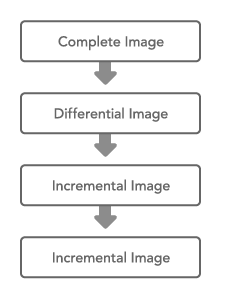To simplify working with O&O DiskImage, certain terms will be explained in the following chapters:
Drive/Partition
A drive is a reserved area of the hard disk. Multiple drives can be found on a hard disk. In the following text, the term “drive” will be used to depict (single) partitions as well as logical drives in extended partitions and volumes.
Drives are used, for example, to separate documents from programs. A division in two partitions has become generally accepted:
- Drive C: for operating systems and programs
- Drive D: for documents, e.g. photos, Office documents, music, etc.
This, for example, makes it easier to separate data and system images with O&O DiskImage.
Image
An image is a "mirror" of your drive (partitions). This “copy” contains all information taken from the original. A special feature of an image is that the file format is specially compressed and takes up much less disk space than the original. The more often you create images of your drive, the less you need worry about data loss. Should data on the original drive be lost or damaged, you can restore your last image with all its data onto your computer. With just a few mouse clicks, you can recover the original status of your drive before the last imaging.
An image can be made up of multiple image files (*omg). For example if one disk is not sufficient to store the image and more are needed, e.g. CD/DVDs.
The term image is also used in a wide sense for file backups.
Difference File backup and Drive image
Files are backuped directly in the form of data. This type of image includes only file information, no drive information is imaged. The file format is OBK (*.obk).
A drive image stores all used or all sectors of a drive. This automatically also creates an image of the file system and all files and folders. The file format is OMG (*.omg).
Image file
An image can be made up of one or more image files (*omg). If, for example, the disk where you want to save the image isn't large enough, you can split the image onto multiple disks. When you split your image onto several disks, a new image file will be created on each disk and together, these image files will be parts of one entire image. It's important to number the disks (CD/DVD/Blu-ray) in case you want to later restore a drive using the image, or use it as a base for an incremental imaging.
File formats
O&O DiskImage creates its own file formats when imaging but is also able to process other file formats.
File format OMG
O&O DiskImage generates the file extension (*OMG) for the image files it creates when imaging your entire computer or single drives. This file type can be used for further activities by O&O DiskImage, such as restoration, validation or conversion.
File format OBK
While creating a file backup using O&O DiskImage, the files and folder are compressed and stored as OBK file (*.obk).
File format VHD
O&O DiskImage is able to create and edit file formats for virtual computers (VPC/VM-Ware). This allows you to also mount a drive from an image as a virtual drive in the VPC or your VM-Ware.
Complete image
Using the Complete image method, the data selected for imaging will be imaged all over again and stored in a folder on the target disk. Complete images can be created using the "Used sector", "Forensic", or "Direct forensic" methods.
Differentiation: Image of the changes
If you only want to image changes of your hard disk or drives, you will need to have created at least one complete image previously. Changes made can then be saved as differential and incremental images.

O&O DiskImage: Connection between image types
Base image
A base image is an image that serves as a basis for any further image of the changes. Differential images require a complete image as a base image. Incremental images can usually be made using the last image of the changes as their base image. It's possible, for example, to use a differential image as a base image for an incremental image. In this way, an incremental image can also serve as base image for further incremental images. Also see picture in chapter Image of the changes.
Incremental images
Incremental images only save the changes made since the last base image. As a rule, data is compared using checksums in O&O DiskImage, so that the incremental image does not require a complete image as base image. The last incremental or differential image is enough for doing this. To restore an incremental image, you need the last complete image as well as all the following images recording any changes.
Differential images
Differential images compare present data with the last complete image and store only the changes. The first "successive" image after the complete image is always a differential image. To restore a differential image, you will need both the complete image and the differential image.